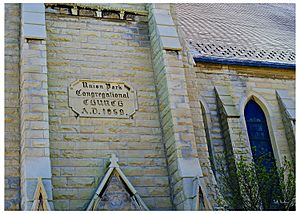First Baptist Congregational Church facts for kids
Quick facts for kids First Baptist Congregational Church |
|
|---|---|

Building designation for the church
|
|
| Religion | |
| Affiliation | United Church of Christ and Baptist |
| Leadership | Rev. George W. Daniels (Senior Pastor) |
| Status | Active |
| Location | |
| Location | Chicago, Illinois, United States |
| Architecture | |
| Architect(s) | Gurdon P. Randall |
| Architectural style | Gothic |
| Completed | 1871 |
| Specifications | |
| Capacity | 1800 |
| Spire(s) | 2 |
| Website | |
| http://www.fbcc-chicago.net/ | |
The First Baptist Congregational Church is a special church in Chicago, Illinois. It's a place where two different Christian groups, the United Church of Christ and Baptists, come together. This historic building is located at 60 N. Ashland Blvd. It is recognized as an Illinois Historic Landmark. It is also listed on the National Register of Historic Places.
Contents
A Look at the Church's History
The church building was designed by a famous architect named Gurdon P. Randall. It was built for the Union Park Congregational Church, which started in 1860. Construction took place between 1869 and 1871.
Helping Chicago After a Big Fire
A very important event happened right after the church was finished. The Great Chicago Fire of 1871 caused huge damage to the city. During this difficult time, the church became a temporary headquarters. The Mayor's Office, City Council, and the General Relief Committee used the church. They worked from there to help the city recover.
How Different Churches Joined Together
Over the years, several churches joined to form the congregation we know today.
- In 1910, the building of the First Congregational Church burned down. This church had been founded in 1851.
- After the fire, Union Park Congregational Church merged with First Congregational. They formed a new group called (New) First Congregational Church.
- Later, two more churches joined this new congregation. Leavitt Street Congregational Church joined in 1917. Bethany Congregational Church joined in the 1920s.
The Baptist Church Joins In
On August 6, 1944, the Mozart Baptist Church was founded. It started at 114 N. Mozart Street in Chicago. By 1951, this church had grown a lot. It moved to a bigger building at 2900 W. Adams Street. In 1970, Mozart Baptist Church merged with First Congregational. This created the First Congregational Baptist Church. The combined church continued to meet in the historic First Congregational building.
The Church's Amazing Design
The church building is made from a special stone called Lemont limestone. It has a roof made of slate. The main part of the church is almost square. It has small sections sticking out on the north and south sides.
Inside the Church: A Unique Seating Style
The inside of the church was designed by Gurdon P. Randall. He created an "amphitheater style" seating arrangement. This means the seats are arranged in a curve, like a theater. This design was perfect for Congregational services, which focus on the sermon. Randall is often given credit for inventing this seating style. Many other churches have copied his idea over the years.
The Carpenter Chapel
Next to the main church, on the south side, is the smaller Carpenter Chapel. It's a long, rectangular space. Its inside is simpler, with plaster and wood. The outside also uses Lemont limestone, matching the main church. The chapel has a spire, and the church has two spires. These spires create a line of increasing height, connecting the two buildings visually.
Damage and Repairs
Sadly, part of the main church's roof and inside were badly damaged. This happened during a big blizzard on February 2, 2011.
A Recognized Landmark
The First Baptist Congregational Church is featured in many books about church architecture. It's in "Chicago Churches: A Photographic Essay" by Elizabeth Johnson. It's also in "Chicago Churches and Synagogues: An Architectural Pilgrimage." This shows how important its design is. The building is an Illinois Historic Landmark. It is also listed on the National Register of Historic Places. On January 21, 1982, it was officially named a Chicago Landmark.

